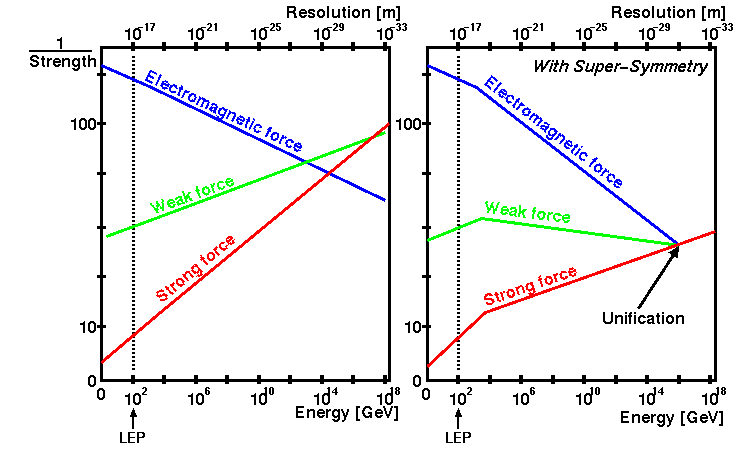
Without SUSY it doesn't seem as if the strengths of the interactions will ever meet. SUSY modifies the way they converge, leading to unification.
You'll have learned about what physicists call the Standard Model. This divides matter particles in to three families, only one of which is needed to make up all the matter in the Universe today. The members of that family are called up-quarks, down-quarks, electrons and electron-neutrinos. The two heavier families are populated by strange-quarks, charm-quarks, muons and muon-neutrinos, and by bottom-quarks, top-quarks, taus and tau-neutrinos.
You'll have learned about the four apparently different interactions that act between these particles:
But there are a number of things that you won't have learned, because nobody knows the answers. Like, for example, why there are three families of particles. Why not more or even just one? And why are the interactions all so different? Why do the fundamental particles have such a wide range of masses, and why is there apparently no antimatter in the Universe?
CERN is currently building a new particle accelerator to allow a new generation of researchers to address these questions. Called the Large Hadron Collider (LHC), it is due to switch on in 2006.
Top of the LHC's priorities is the perplexing question of mass. It is remarkable that such a familiar concept is so poorly understood. The answer may lie within the Standard Model, in an idea called the Higgs mechanism after one of the physicists that developed it. According to this, the whole of space is filled with a "Higgs field", and by interacting with this field, particles acquire their masses. Particles that interact strongly with the Higgs field are heavy, whilst those that interact weakly are light. The Higgs field has at least one new particle associated with it, the Higgs boson, which is the carrier of the Higgs interaction. The LHC will be able to make this particle, if it exists at all, in large numbers for scientists to study.
And what about interactions? Scientists dream of unifying all the interactions into the same theory. They think that when the Universe was young and very hot, all the interactions behaved in the same way and had the same strength. It is only in as the Universe cooled that they split off into four separate interactions.
We have already seen evidence that the scientists might be right. If you do the "Strong coupling constant" project, you will see that the strength of the strong interaction changes with energy. The higher the energy the weaker it becomes. The strengths of other interactions have also been measured at different energies and it seems that as energy rises, so the strengths of the interactions converge. The LHC will be able to test the continuation of this trend to higher energies than we have so far been able to achieve.
A very popular theory that may prove to be the successor to the Standard Model is called "supersymmetry", SUSY for short. It proposes that for every kind of matter particle there is an interaction carrying partner and vice versa. If supersymmetry is included in the calculations, then extrapolating all the interactions back to the temperature of the early Universe leads all their strengths to meet at just the right point. Without SUSY, they never meet. If SUSY is right, then supersymmetric particles should be found at the LHC.

Without SUSY it doesn't seem as if the strengths of the interactions will ever meet. SUSY modifies the way they converge, leading to unification.
Antimatter poses another riddle the LHC will help us to solve. At the Universe's birth, matter and antimatter are believed to have been created in equal amounts, yet today we live in a Universe apparently made entirely of matter. So where has all the antimatter gone? It was once thought that antimatter was a perfect "reflection" of matter - that if you replaced matter with antimatter and looked at the result in a mirror, you would not be able to tell the difference. We now know that the reflection is imperfect, and this could have led to the matter-antimatter imbalance.
The LHC will be a very good "antimatter-mirror", allowing us to put the Standard Model through one of its most gruelling tests yet.
These are just a few of the questions the LHC should answer, but history has shown that the greatest advances in science are often unexpected. Although we have a good idea of what we hope to find at the LHC, nature may well have surprises in store.